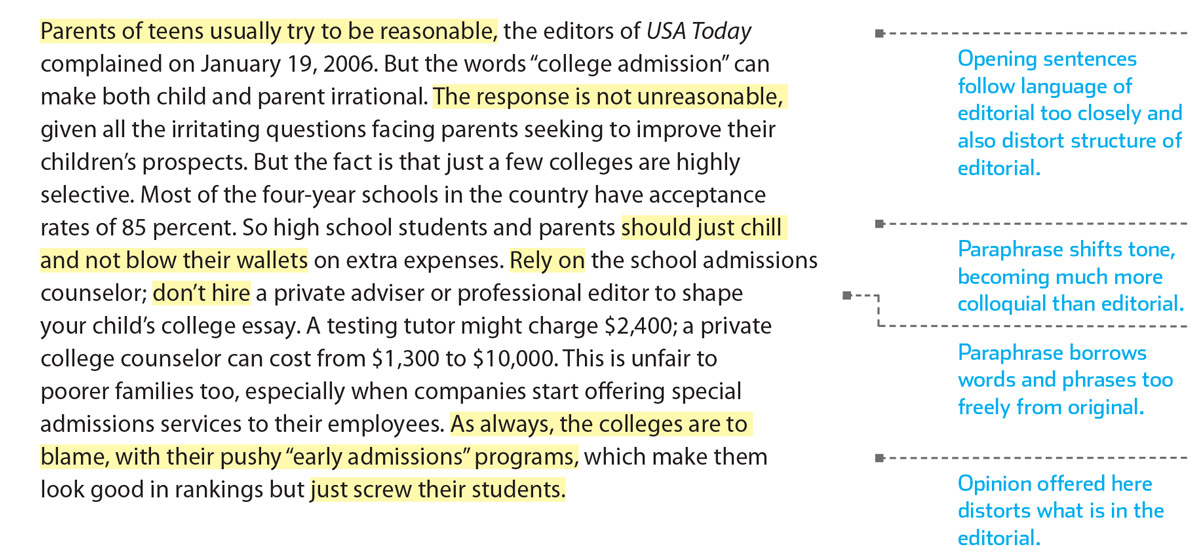Paraphrasing Sources
Chapter Opener
43
restate ideas
Paraphrasing Sources
Paraphrases provide more complete records of the research materials you examine than do summaries. (sum up ideas) Like a summary, a paraphrase records a book or article’s main point, but it also recaps the reasons and key evidence supporting that conclusion. Paraphrase any materials you expect to use extensively in a project. Then consider how the research materials you have gathered stand in relationship to each other.
Identify the major claims and the structure of the source. Determine the main points made by the article, chapter, or text you are paraphrasing, and examine how the work organizes information to support its claims. (think critically) Then follow the same structure when you paraphrase the source. For example, your paraphrase will probably be arranged sequentially when a work has a story to tell, be arranged topic by topic when you’re dealing with reported information, or be structured logically — by claims and evidence — when you take notes from arguments or editorials.
Track the source faithfully. A paraphrase should move through an article, chapter, or book succinctly while remaining faithful to its purpose, organization, tone, and, to some extent, style. In effect, you are preparing an abstract of the material, complete and readable on its own. Take concise and practical notes, adapting the paraphrase to your needs — understanding that materials especially valuable to your project will need to be described thoroughly. (take notes)
Record key pieces of evidence. Thanks to photocopies and downloaded files, you don’t usually have to copy data laboriously into your notes — and you probably shouldn’t. (Chances of error greatly multiply whenever you transcribe information by hand.) Be certain, though, that your paraphrase sets down supporting reasons for all major claims in the source, as well as key evidence and facts. Key evidence is whatever proves a point or seals the deal in an argument. Keep track of page numbers for all the important data so you can cite this material in your paper without having to return to the original source.
Be certain your notes are entirely in your own words. If you copy the language of sources as you paraphrase them, you risk plagiarism. Deliberately or not, you could transfer big chunks of someone else’s writing into your project. But if you have paraphrased by the rules, setting all borrowed words between quotation marks, it’s safe to import those notes directly into your project — giving the original writers due credit for their ideas, of course. When you write competent paraphrases, you’ve already started to compose your own paper. There is no lost motion.
The following is a possible paraphrase of “Sanity 101,” the complete, fully annotated text of which appears in Chapter 41. Compare the paraphrase here to the briefer summaries of the article that appear in Chapter 42.
In an editorial entitled “Sanity 101” (January 19, 2006), the editors of USA Today worry that many fearful parents are resorting to costly measures to help assure their child’s college admission, some hiring private counselors and tutors that poorer families can’t afford. Companies now even offer college admission assistance as part of employees’ job packages. Colleges themselves are to blame for the hysteria, in part because of “early admission” practices that benefit them more than students. But parents and students should consider the facts. Only a handful of colleges are truly selective; most have acceptance rates near 85 percent. In addition, most schools care more about students than about their own rankings.
Avoid misleading or inaccurate paraphrasing. Your notes won’t be worth much if your paraphrases of sources distort the content of what you read. Don’t rearrange the information, give it a spin you might prefer, or offer your own opinions on a subject. Make it clear, too, whenever your comments focus just on particular sections or chapters of a source, rather than on the entire piece. That way, you won’t misread your notes days later and give readers a wrong impression about an article or book. The following is a paraphrase of “Sanity 101” that gets almost everything wrong.

Use your paraphrases to synthesize sources. If you are asked to prepare a literature review or synthesis paper on a subject, begin that work by carefully summarizing and paraphrasing a range of reputable sources. For more about synthesis and synthesis papers, see Chapter 12. (understand synthesis papers)